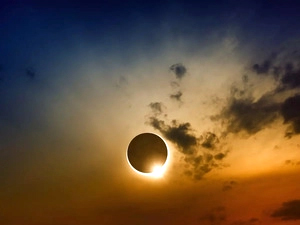Total lunar eclipse on November 8
STATE TIMES NEWS

Kolkata: A fortnight after the partial solar eclipse, Kolkata as well as other parts of India and the globe will witness a total lunar eclipse on November 8, an eminent astrophysicist said.
Besides India and neighbouring Pakistan, Afghanistan and parts of Russia, residents of other parts of Asia, North and South America, Australia, North Atlantic Ocean, Pacific Ocean will be able to see the celestial event, said astrophysicist Debi Prasad Duari.
The lunar eclipse in its totality will not be observed from everywhere, Duari said, adding that the beginning of the partial phase of the eclipse will be seen from some countries of Latin America.
On November 8, the partial eclipse of the moon will begin at around 14:39 hours (IST) and will reach its totality phase around 15:46 hours. The eclipse in terms of the darkness of the moon will be maximum, at 16:29 hours. when the moon will be deep inside the shadow of the earth.
The total eclipse will end at around 17:11 hours and ultimately the partial eclipse will end around 18:19 hours, he said.
“The eclipse will be visible from all parts of India from the moonrise time, but the beginning phase both the partial and total eclipse will not be visible because both the event begins when the moon is below the horizon everywhere in India,” Duari said.
Some parts of eastern India including Kolkata, will experience the total phase of the lunar eclipse, whereas in rest of the country people will only be able to see the progression of the partial phase of the eclipse which will end at around 18:19 hours, he elaborated.
In the city, the moon will start rising from the eastern horizon at around 16:52 hours and will be completely visible by 16:54 hours.
“So, till 17:11 hours it will be total lunar eclipse after which the moon will enter the partial eclipse phase and will become more illuminated as time progresses,” he said.
Cities in the eastern part of the country like Kohima, Agartala, Guwahati will observe the total eclipse earlier than Kolkata because of their position.
“Only in Kohima, the eclipse at its maximum phase can be observed at around 16:29 hours, when the moon will cross the darkest part of the earth’s shadow,” he said.
New Delhi will experience a partial eclipse from moonrise at around 17:31 hours with 66 per cent obscuration of the moon since the total phase of the eclipse has already ended by then at 17:11 hours, the astrophysicist said.
In Bengaluru, the moon will completely rise at 17:57 hours with 23 per cent of its disc obscured by the earth’ shadow, while Mumbai will see it at around 18:03 hours with only 14 per cent obscuration.
In Nagpur, the moon will rise around 17:32 hours with 60 per cent of the disc obscured at around 17:34 hours, when the complete moon will be above the horizon for the eclipse to be effectively seen while in Srinagar, the eclipsed moon with an obscuration of nearly 66 per cent will rise above the horizon at 17:31 hours.
Urging people not to look at the full moon for a long period, since it may cause some uneasiness and irritation for some, Duari explained that a total lunar eclipse takes place when the full moon passes through the shadow region of the earth and for some time it will be eclipsed.
“A lunar eclipse occurs during a full moon night, when because of the alignment of the sun, earth and the moon almost on the same plane, in a straight line. During this alignment the moon passes through the shadow region of the earth for some time,” he said.
The next total lunar eclipse that can be seen from India will occur on September 7, 2025, although in October 2023, a minor partial eclipse will be observed from India, Duari added.
